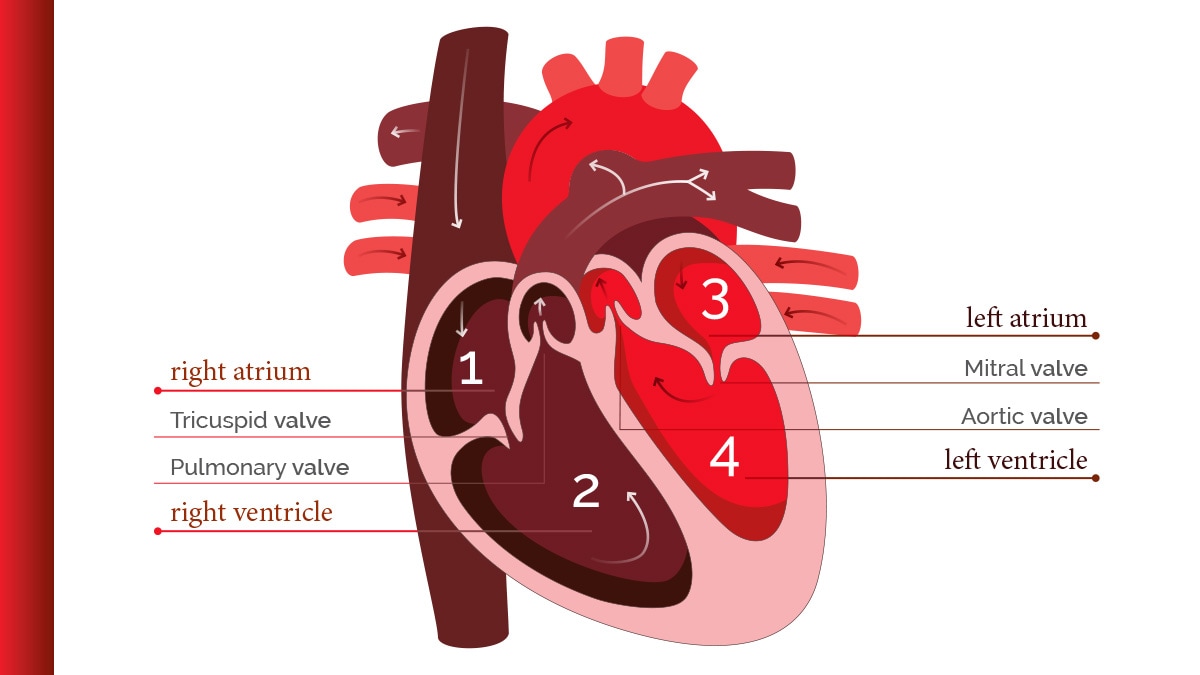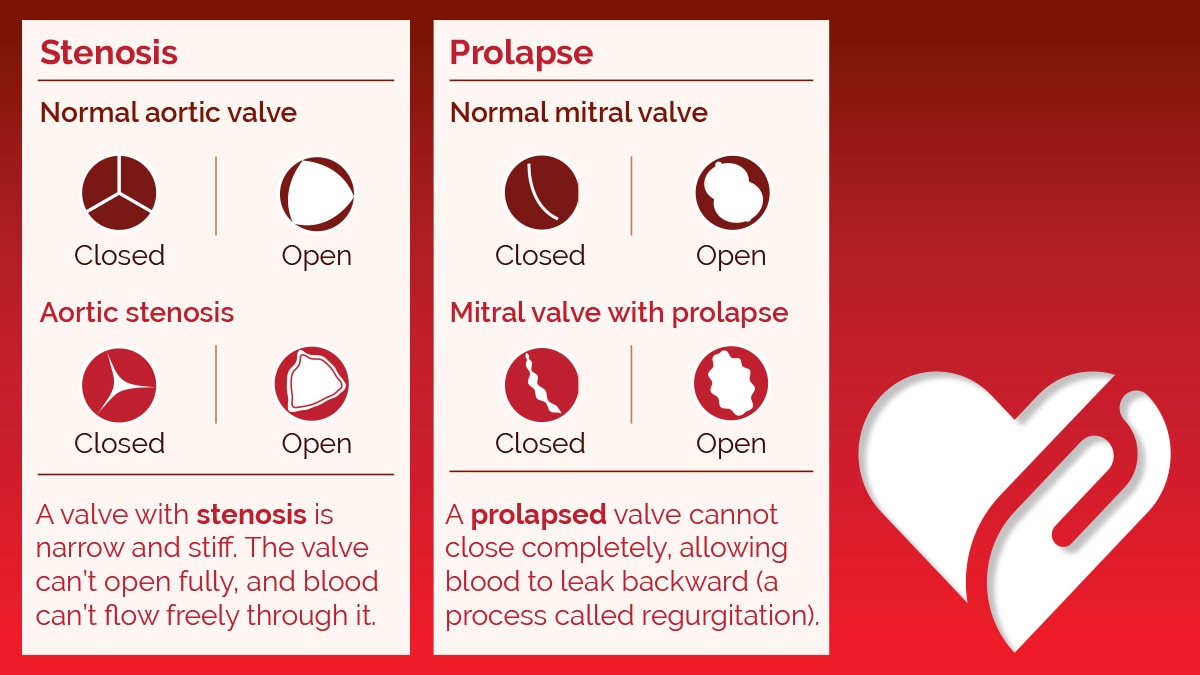Key points
- Heart valve disease isn't as common as many other heart conditions, so patients may not easily recognize its signs and symptoms.
- Symptoms of heart valve disease may be subtle and develop slowly over time.
- Discuss heart valve disease screening and treatment with your health care team.

What it is
Heart valve disease is when any valve in the heart has damage or is diseased. There are several causes of valve disease.
- The normal heart has four chambers (right and left atria, and right and left ventricles) and four valves (Figure 1).
- The mitral valve, also called the bicuspid valve, allows blood to flow from the left atrium to the left ventricle.
- The tricuspid valve allows blood to flow from the right atrium to the right ventricle.
- The aortic valve allows blood to flow from the left ventricle to the aorta.
- The pulmonary valve allows blood to flow from the right ventricle to the pulmonary artery.

The valves open and close to control or regulate the blood flowing into the heart and then away from the heart. Diseased valves might not fully open and close. Any valve in the heart can become diseased, but the aortic valve is most commonly affected.
Diseased valves can become prolapsed where they don't completely close; this is called regurgitation. If this happens, blood leaks back into the chamber and not enough blood can be pushed forward through the heart (Figure 2).
The other common type of heart valve condition happens when the opening of the valve is narrowed and stiff and the valve is not able to open fully when blood is trying to pass through; this is called stenosis (Figure 2).

Facts about heart valve disease
- 75% of U.S. adults know little to nothing about heart valve disease1.
- Even those at the highest risk, people 65 years and older, are poorly informed about heart valve disease1.
- More than 5 million people in the U.S. are diagnosed with heart valve disease each year2.
- More than 25,000 deaths in the U.S. each year are due to heart valve disease3.
- Heart valve disease is underdiagnosed and undertreated, especially in African American, Hispanic, and Asian populations4.
- Women are more likely than men to not be diagnosed and to experience worse health outcomes from the condition5.
Symptoms
Heart valve disease can develop quickly or over a long period. When heart valve disease develops more slowly, there may be no symptoms until the condition is quite advanced. When it develops more suddenly, people may experience the following symptoms:
- Shortness of breath
- Chest pain
- Fever
- Irregular heartbeat
- Dizziness or fainting
- Rapid weight gain
- Swelling around the eyes, ankles, or abdomen
- Fatigue, or feeling tired, especially during activity
Risk factors
By learning about family health history and individual risk, people can begin to know what concerns to discuss regarding heart valve disease with their health care team. Risk factors include:
- Older ages (in the United States, narrowing of the aortic valve (aortic stenosis) affects 5% of people aged 65 years and older6).
- Family history of heart valve disease or other heart disease.
- A personal history of heart disease, such as heart failure or heart attack.
- High blood pressure, high cholesterol, diabetes, smoking, and obesity.
- Congenital heart disease (heart valves formed incorrectly before birth).
- A history of rheumatic disease or endocarditis.
- Previous infections, such as rheumatic fever and blood infections.
- Certain autoimmune diseases.
- Radiation exposure and chemotherapy during cancer treatment.
Causes
There are several causes of heart valve disease, including congenital conditions (being born with it), infections, degenerative conditions (wearing out with age), and conditions linked to other types of heart disease.
Rheumatic disease can happen after an infection from the bacteria that causes strep throat is not treated with antibiotics. The infection can cause scarring of the heart valve. This is the most common cause of valve disease worldwide, but it is much less common in the United States, where most strep infections are treated early with antibiotics. It is, however, more common in the United States among people born before 1943.
Endocarditis is an infection of the inner lining of the heart caused by a severe infection in the blood. The infection can damage the heart valve. Intravenous drug use can also lead to endocarditis and cause heart valve disease.
Congenital heart valve disease is malformations of the heart valves. The most commonly affected valve with a congenital defect is a bicuspid aortic valve.
Other types of heart disease:
- Heart failure. Heart failure happens when the heart cannot pump enough blood and oxygen to support other organs in your body.
- Atherosclerosis. Atherosclerosis refers to a buildup of plaque on the inside of the blood vessel. Plaque is made up of fat, calcium, and cholesterol.
- Thoracic aortic aneurysm, a bulge or ballooning where the aorta attaches to the heart.
- High blood pressure.
- A heart attack (also known as myocardial infarction or MI), which can damage the muscles that control the opening and closing of the valve.
Other causes for heart valve disease:
- Autoimmune disease, such as lupus.
- Marfan syndrome, a disease of connective tissue that can affect heart valves.
- Exposure to high-dose radiation, which may lead to calcium deposits on the valve.
- The aging process, which can cause calcium deposits to develop on the heart valves, making them stiff or thickened and less efficient with age.
Prevention
People may help to reduce their risk for heart valve disease by:
- Making heart-healthy choices by:
- Choosing heart-healthy foods, such as fresh fruits and vegetables.
- Following CDC physical activity guidelines for heart health.
- Managing stress.
- Choosing heart-healthy foods, such as fresh fruits and vegetables.
- Getting to know your heart health by:
- Getting annual physical checkups, including having a health care professional listen to your heart with a stethoscope.
- Letting your health care team know if you have noticed changes in your heartbeat.
- Getting annual physical checkups, including having a health care professional listen to your heart with a stethoscope.
- Taking care of your overall health by:
- Having a good daily oral hygiene routine and getting regular dental checkups to reduce risk of heart infection.
- Getting treatment for respiratory infections such as strep throat.
- Taking antibiotics as instructed to prevent infection (such as when they are prescribed before surgery or dental procedures).
- Having a good daily oral hygiene routine and getting regular dental checkups to reduce risk of heart infection.
Testing and diagnosis
- People should talk with their health care team about their family's heart health history.
- It is never too early for parents and guardians to discuss heart health as a part of pediatric wellness visits, especially if there is a family history of heart problems.
- Pediatricians play a key role in identifying congenital heart valve disease that may not have been detected at birth or during prenatal care.
- Early diagnosis, treatment, and routine monitoring of heart valve disease are critical to helping patients live healthy lives.
- Screenings such as stethoscope checks, echocardiograms, and timely referrals to cardiologists can help ensure that heart valve disease does not go unmanaged.
- Effective treatment options are available for heart valve disease, including noninvasive options. It is important to discuss the options that are best and what follow-up care may be recommended for each patient.
- As with any heart condition, continued care and regular screenings to monitor disease progression are needed for people who are living with heart valve disease.
- Screenings such as stethoscope checks, echocardiograms, and timely referrals to cardiologists can help ensure that heart valve disease does not go unmanaged.
Treatment and recovery
Most cases of heart valve disease can be treated. You may be prescribed medicines to treat your symptoms. These may include drugs to treat high blood pressure or heart rate, or blood thinners. If your valve is causing more severe symptoms, your health care team may recommend surgery. The type of surgery will depend on the valve affected and the cause of the disease. This will be by either opening the heart during surgery or replacing the valve without having to open the heart during surgery.
- Belden Russonello Strategists and the Alliance for Aging Research. Public Awareness of Heart Valve Disease. https://www.agingresearch.org/wp-content/uploads/2017/12/Public20Awareness20of20Heart20Valve20Disease_Omnibus20Survey_Final.pdf
- Nkomo, Vuyisile T et al. Burden of valvular heart diseases: a population-based study. (2006). The Lancet Journal, 368(9540), P1005-1011.
- Centers for Disease Control and Prevention, National Center for Health Statistics. Underlying Cause of Death 2018-2021 on CDC WONDER Online Database. Data are from the Multiple Cause of Death Files, 2018-2021, as compiled from data provided by the 57 vital statistics jurisdictions through the Vital Statistics Cooperative Program. http://wonder.cdc.gov/ucd-icd10.html
- Ahmed Y, Van Bakel PAJ, Hou H, et al. Racial and ethnic disparities in diagnosis, management and outcomes of aortic stenosis in the Medicare population. PLOS ONE. 18(4): e0281811. doi: 10.1371/journal.pone.0281811
- DesJardin JT, Chikwe J, Hahn RT, et al. Sex Differences and Similarities in Valvular Heart Disease. Circulation Research. 130(4):455-473. doi: 10.1161/CIRCRESAHA.121.319914
- Pinto, R. a. C. (n.d.). Epidemiology of aortic valve stenosis (AS) and of aortic valve incompetence (AI): is the prevalence of AS/AI similar in different parts of the world? https://www.escardio.org/Journals/E-Journal-of-Cardiology-Practice/Volume-18/epidemiology-of-aortic-valve-stenosis-as-and-of-aortic-valve-incompetence-ai
